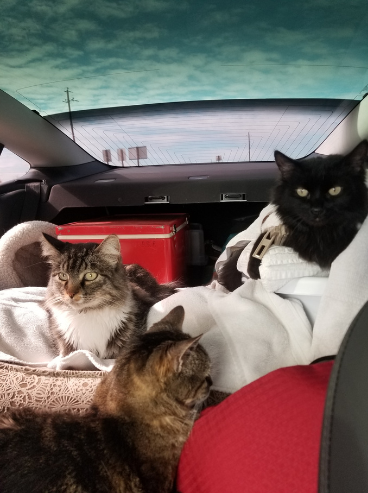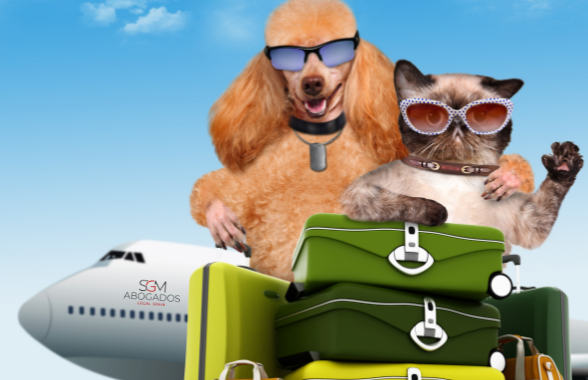Travelling from the Spain to UK with Pets?
How can I travel with my pet from Spain to the UK without it going in the hold?
As pets are not allowed to travel in the cabin of planes from Spain to the United Kingdom, what alternative routes are available to pet owners who don’t want their furry friends to fly as cargo down below in the aircraft’s hold?
Many people in Spain own pets, around one in four households, and this is true too of foreign residents.
But what happens when you want to travel to the UK with your furry friend – is there any way for your pet to travel without going in the hold?
Unfortunately, the short answer is that no pets are permitted to fly in the cabin on any flight into the UK.
This is down to government regulations. The UK is considered rabies-free, which means that there are very strict protocols to follow when importing a pet.

The only animals that may be permitted to fly in the cabin are registered assistance dogs, even then they are still only allowed on certain routes on particular airlines. Emotional support animals do count but must still travel in the hold.
This means that if you don’t want your pet to fly as cargo, you will have to find alternative routes to get them into the UK.
According to the UK government website, you can enter with your pet cat, dog or ferret only if it:
- has been microchipped
- has a pet passport or health certificate
- has been vaccinated against rabies
Dogs must also have a tapeworm treatment before travel. If you do not abide by the above rules, your pet may be put into quarantine for up to 4 months and you will have to pay any fees or charges.
For many pet owners, the prospect of having to be separate from their furry friends on a flight, without being able to check on them, is a major source of worry. They’re often kept in crates in the cargo hold.
Will the experience be traumatising for them? Will they be taken care of in situations of extreme heat or cold or poor ventilation? There have been cases of pets dying or getting injured as a result of being in these often difficult transport conditions, so for many owners, the risks are just not worth it.
But what are the alternatives if you still want to take your pet with you from Spain to the UK but you want to make sure they’re by your side at all times?
By car
If your pet is used to travelling in the car on long journeys, this will most likely be one of the easiest ways of travelling with them from Spain to the UK. It means that you can stop as often as you want for toilet and water breaks, and also stop overnight along the way if you need to.
A non-stop car journey between Madrid and London (1,726km distance) will take at the very least 19 hours, but you should expect it to be considerably longer if you include stops.
When you get to Calais, you can take your vehicle (and your pets inside) on the Eurotunnel Le Shuttle over to Dover in just 35 minutes.
Keep in mind, your pet will not be able to leave the vehicle during this crossing. In order words, your pet won’t be allowed in the passenger seating area.
Standard prices for the Eurotunnel start from around €100 depending on the size of your vehicle.

By train (and taxi)
Travelling by train with your pets may seem like an easy and great alternative to flying, however one of the main problems is that Eurostar doesn’t allow any pets on board, with the exception of guide dogs and assistance dogs.
This means that travelling by train is going to be a lot more complicated than you might have first thought.
Firstly in Spain, Renfe states that on Ave and long-distance (Larga Distancia) trains, you can travel with your pet as long as:
- It’s a dog, cat, ferret, but not poultry
- Does not weigh more than 10kg
- Always travels inside a cage or carrier, with a maximum size of 60x35x35 cm
- Only one pet per person allowed
- Your ticket allows travel with a pet
The pet ticket is free if you travel with a Premium ticket, in a Preferential or Grand Class bed or a Grand Comfort Seat. For Basic tickets, the cost of adding your pet to the ticket starts at €10.
However, larger dogs are not allowed on the AVE long-distance trains or the media distancia (medium distance) and Avant trains. If you have a larger dog, you will most likely need to take the much slower local Cercanías trains and then Rodalies in Catalonia up to the Pyrenees to cross into France.
Once in France, you are able to take small dogs under 6kg with you, as long as they travel in a carrier not exceeding 45cm x 30cm x 25cm. Larger dogs must wear a muzzle and be on a leash. They will pay half the price of a 2nd class full fare. Pet tickets cannot be booked online so you will need to call ahead of time to book.
When you reach Paris, you will have to find a way to get to the UK via the Eurotunnel instead of the Eurostar. This means either hiring a car to get across or taking a taxi.
Rail travel website The Man in Seat 61 recommends Taxi Company Folkestone Taxis, who provide a special pet taxi service for you and your pooch. They will be able to take you from the port in Calais to the port in Folkestone with prices starting at around £125, with the cost of the Eurotunnel ticket added on top.
When you finally reach the UK, you can take dogs, cats and other small animals with you for free on all trains. There is a maximum of two allowed per passenger. Dogs must be kept on a lead at all times or put in a carrier. Other smaller animals must be kept in cages or carriers, however, they cannot go on seats, otherwise, you will incur a fine.
By ferry

If you want to travel by ferry from either Spain or France with your pet, this can also be a good option. Although it may possibly take longer, it could be more comfortable for your pet than the combination of different trains and taxis. However, many ferries don’t allow foot passengers to take pets, so again, you may need your own car. On ferries, pets can either stay in your car, in a pet-friendly cabin or in the onboard kennels.
Brittany Ferries is one of the few ferry companies to offer pet-friendly cabins and exercise areas on some vessels.
Brittany Ferries’ Galicia and Santander both have pet-friendly cabins and sail on routes from Santander to Portsmouth and Cherbourg to Portsmouth. Pont Aven also has pet-friendly cabins on its routes from Santander to Plymouth.
All these ferries with pet-friendly cabins have a pet exercise area onboard, but pets must be muzzled and on a leash when not in the cabin.
The cost of taking a pet on board costs approximately €45 each way from Spain and around €29 each way from ports in France. On average, ferries between northern Spain and the UK take between 24 and 28 hours.
P&O Ferries also accept dogs, cats and ferrets on the Dover to Calais route for around €15 per pet each way. However, pets must stay in your car for the entire crossing. You are not allowed to take one if you are a foot passenger.
By plane to France
Another option that could save you some time could be to fly from where you are in Spain to Paris and from there go to Calais by train, and then take a taxi across to the UK.
This will of course depend on the size of your pet and your airline’s requirements, but if they are small (usually below 8kg with the weight of the carrier) they can travel with you in the plane’s cabin and then next to you on the bus, train or taxi.
As with the other options mentioned above, these alternative routes can be longer and more expensive than just flying to the UK from Spain with your pet in the hold.
Many thanks to THE LOCAL es











